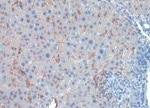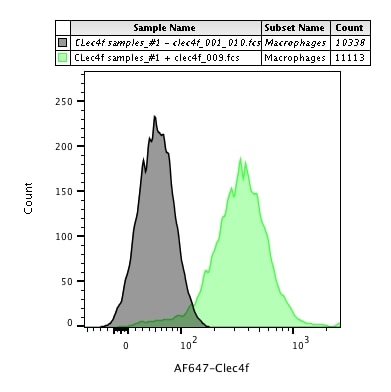Mouse CLEC4F/CLECSF13 Antibody Summary
Ala65-Gly548
Accession # P70194
Applications
Please Note: Optimal dilutions should be determined by each laboratory for each application. General Protocols are available in the Technical Information section on our website.
Scientific Data
 View Larger
View Larger
CLEC4F/CLECSF13 in Mouse Liver. CLEC4F/CLECSF13 was detected in perfusion fixed frozen sections of mouse liver using Rat Anti-Mouse CLEC4F/CLECSF13 Monoclonal Antibody (Catalog # MAB2784) at 5 µg/mL overnight at 4 °C. Tissue was stained using the Anti-Rat HRP-DAB Cell & Tissue Staining Kit (brown; Catalog # CTS017) and counterstained with hematoxylin (blue). Specific staining was localized to Kupffer cells. View our protocol for Chromogenic IHC Staining of Frozen Tissue Sections.
 View Larger
View Larger
Detection of Mouse CLEC4F/CLECSF13 by Immunocytochemistry/Immunofluorescence CETP protein is not co‐localized with Ly6C protein, but does co‐localize with Clec4f protein. Livers of non‐injected female APOE*3‐Leiden‐CETP mice were assayed for co‐localization of CETP and F4/80 (A), Ly6C (B) and Clec4f (C). Red; F4/80, Ly6C or Clec4f, Green; CETP, Blue; DAPI. Double headed arrows indicate co‐localization, single‐headed arrows indicate no co‐localization. CETP indicates cholesteryl ester transfer protein; Clec4f, C‐type lectin domain family 4; Ly6C, lymphocyte antigen 6 complex locus C. Image collected and cropped by CiteAb from the following publication (https://pubmed.ncbi.nlm.nih.gov/29525783), licensed under a CC-BY license. Not internally tested by R&D Systems.
Reconstitution Calculator
Preparation and Storage
- 12 months from date of receipt, -20 to -70 °C as supplied.
- 1 month, 2 to 8 °C under sterile conditions after reconstitution.
- 6 months, -20 to -70 °C under sterile conditions after reconstitution.
Background: CLEC4F/CLECSF13
CLEC4F (C-type lectin domain; family 4, member F; also known as the Kupffer cell receptor and fucose receptor) is an 80 kDa, type II transmembrane glycoprotein member of the C-type lectin superfamily (1‑3). Mature mouse CLEC4F consists of a 42 amino acid (aa) cytoplasmic domain, a 27 aa transmembrane segment, and a 479 aa extracellular domain (ECD) that contains an extended stalk region plus one carbohydrate recognition domain (4, 5). Within the ECD, mouse CLEC4F shares 48% and 79% aa sequence identity with human and rat CLEC4F, respectively. The stalk region of CLEC4F is a coiled coil domain that mediates homotrimer formation (6, 7). CLEC4F is expressed on Kupffer cells in the liver, but not on macrophages in other tissues (8). CLEC4F preferentially binds galactose and N‑acetylgalactosamine in a calcium-dependent manner (6, 9, 10). Its activity at neutral, but not at acidic pH, suggests a capacity to internalize and release ligands into the endosomal system (11).
- Zelensky, A.N. and J.E. Gready (2005) FEBS J. 272:6179.
- Bilzer, M. et al. (2006) Liver Int. 26:1175.
- Kuiper, J. et al. (1994) Biochem. J. 299:285.
- Accession # P70194.
- Hoyle, G.W. and R.L. Hill (1988) J. Biol. Chem. 263:7487.
- Fadden, A.J. et al. (2003) Glycobiology 13:529.
- Beavil, A.J. et al. (1992) Proc. Natl. Acad. Sci. 89:753.
- Haltiwanger, R.S. et al. (1986) J. Biol. Chem. 261:7433.
- Coombs, P.J. et al. (2006) Glycobiology 16:1C.
- Biessen, E.A.L. et al. (1994) Biochem. J. 299:291.
- Lehrman, M.A. et al. (1986) J. Biol. Chem. 261:7426.
Product Datasheets
Citations for Mouse CLEC4F/CLECSF13 Antibody
R&D Systems personnel manually curate a database that contains references using R&D Systems products. The data collected includes not only links to publications in PubMed, but also provides information about sample types, species, and experimental conditions.
16
Citations: Showing 1 - 10
Filter your results:
Filter by:
-
Osteopontin Expression Identifies a Subset of Recruited Macrophages Distinct from Kupffer Cells in the Fatty Liver
Authors: Anneleen Remmerie, Liesbet Martens, Tinne Thoné, Angela Castoldi, Ruth Seurinck, Benjamin Pavie et al.
Immunity
-
Savior Siblings Might Rescue Fetal Lethality But Not Adult Lymphoma in Irf2bp2-Null Mice
Authors: Ragnar O. Vilmundarson, Niloufar Heydarikhorneh, An Duong, Tiffany Ho, Kianoosh Keyhanian, Fariborz Soheili et al.
Frontiers in Immunology
-
Inhibiting LXR alpha phosphorylation in hematopoietic cells reduces inflammation and attenuates atherosclerosis and obesity in mice
Authors: Maud Voisin, Elina Shrestha, Claire Rollet, Cyrus A. Nikain, Tatjana Josefs, Mélanie Mahé et al.
Communications Biology
-
Adipocyte Death Preferentially Induces Liver Injury and Inflammation Through the Activation of Chemokine (C-C Motif) Receptor 2-Positive Macrophages and Lipolysis
Authors: Seung-Jin K, Dechun F, Adrien G et al.
Hepatology.
-
Characteristic gene expression in the liver monocyte-macrophage-DC system is associated with the progression of fibrosis in NASH
Authors: Wang X, Wang Z, Liu B et al.
Frontiers in Immunology
-
Savior Siblings Might Rescue Fetal Lethality But Not Adult Lymphoma in Irf2bp2-Null Mice
Authors: Ragnar O. Vilmundarson, Niloufar Heydarikhorneh, An Duong, Tiffany Ho, Kianoosh Keyhanian, Fariborz Soheili et al.
Frontiers in Immunology
Species: Transgenic Mouse
Sample Types: Whole Tissue
Applications: Immunohistochemistry -
Kupffer cell receptor CLEC4F is important for the destruction of desialylated platelets in mice
Authors: Y Jiang, Y Tang, C Hoover, Y Kondo, D Huang, D Restagno, B Shao, L Gao, J Michael Mc, M Zhou, R Silasi-Man, S McGee, M Jiang, X Bai, F Lupu, C Ruan, JD Marth, D Wu, Y Han, L Xia
Cell Death and Differentiation, 2021-05-15;0(0):.
Species: Mouse
Sample Types: Whole Tissue
Applications: IHC -
Inhibiting LXR alpha phosphorylation in hematopoietic cells reduces inflammation and attenuates atherosclerosis and obesity in mice
Authors: Maud Voisin, Elina Shrestha, Claire Rollet, Cyrus A. Nikain, Tatjana Josefs, Mélanie Mahé et al.
Communications Biology
Species: Mouse
Sample Types: Whole Tissue
Applications: Immunohistochemistry -
In vivo liposomal delivery of PPARalpha/gamma dual agonist tesaglitazar in a model of obesity enriches macrophage targeting and limits liver and kidney drug effects
Authors: V Osinski, DK Bauknight, SSK Dasa, MJ Harms, T Kroon, MA Marshall, JC Garmey, AT Nguyen, J Hartman, A Upadhye, P Srikakulap, A Zhou, G O'Mahony, AL Klibanov, KA Kelly, J Boucher, CA McNamara
Theranostics, 2020-01-01;10(2):585-601.
Species: Mouse
Sample Types: Whole Tissue
Applications: IHC -
Adipocyte Death Preferentially Induces Liver Injury and Inflammation Through the Activation of Chemokine (C-C Motif) Receptor 2-Positive Macrophages and Lipolysis
Authors: Seung-Jin K, Dechun F, Adrien G et al.
Hepatology.
-
Lipopolysaccharide Lowers Cholesteryl Ester Transfer Protein by Activating F4/80+Clec4f+Vsig4+Ly6C- Kupffer Cell Subsets
Authors: SJL van der Tu, Z Li, JFP Berbée, I Verkouter, LE Ringnalda, AE Neele, JB van Klinke, SS Rensen, J Fu, MPJ de Winther, AK Groen, PCN Rensen, K Willems va, Y Wang
J Am Heart Assoc, 2018-03-10;7(6):.
Species: Mouse
Sample Types: Whole Tissue
Applications: IHC -
Characteristic gene expression in the liver monocyte-macrophage-DC system is associated with the progression of fibrosis in NASH
Authors: Wang X, Wang Z, Liu B et al.
Frontiers in Immunology
-
Characterization of the CDAA Diet-Induced Non-alcoholic Steatohepatitis Model: Sex-Specific Differences in Inflammation, Fibrosis, and Cholesterol Metabolism in Middle-Aged Mice
Authors: Dániel Kucsera, Viktória E. Tóth, Dorottya Gergő, Imre Vörös, Zsófia Onódi, Anikó Görbe et al.
Frontiers in Physiology
-
CD11c+ resident macrophages drive hepatocyte death-triggered liver fibrosis in a murine model of nonalcoholic steatohepatitis.
Authors: Itoh M, Suganami T, Kato H et al.
JCI Insight.
-
Importance of thorough tissue and cellular level characterization of targeted drugs in the evaluation of pharmacodynamic effects
Authors: Dustin K. Bauknight, Victoria Osinski, Siva Sai Krishna Dasa, Anh T. Nguyen, Melissa A. Marshall, Julia Hartman et al.
PLOS ONE
-
Spatial proteogenomics reveals distinct and evolutionarily conserved hepatic macrophage niches
Authors: Guilliams M, Bonnardel J, Haest B Et al.
Cell
FAQs
No product specific FAQs exist for this product, however you may
View all Antibody FAQsReviews for Mouse CLEC4F/CLECSF13 Antibody
Average Rating: 4.5 (Based on 2 Reviews)
Have you used Mouse CLEC4F/CLECSF13 Antibody?
Submit a review and receive an Amazon gift card.
$25/€18/£15/$25CAN/¥75 Yuan/¥2500 Yen for a review with an image
$10/€7/£6/$10 CAD/¥70 Yuan/¥1110 Yen for a review without an image
Filter by:


